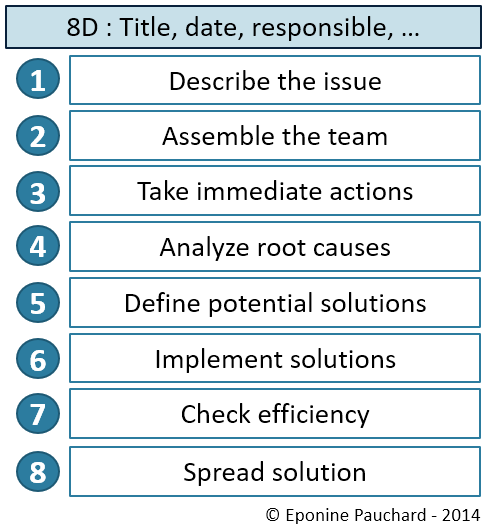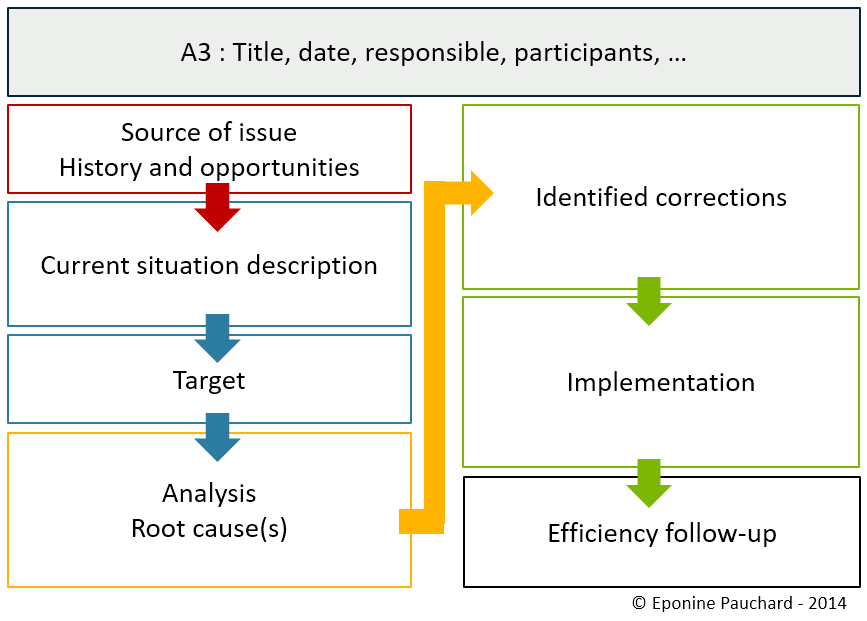In any organization, teams encounter problems. If everything went as planned, life would be very sad. So we have to solve problems. It is a daily activity for thousands of employees.
Everyone knows how to solve problems. But to get rid of it definitively, it is necessary to provide a methodology and simple tools to the teams.

Process improvement experts have a very wide range of techniques. But these few experts cannot solve the problems of an entire organization. This is why we must be able to offer everyone a simple methodology, and to accompany it with some simple tools. In this post, I propose two approaches: the 8D and the A3.
They must be able to solve the majority of their daily problems. A team of experts will be able to provide support, ensure proper monitoring of the methodology, analyze trends and solve problems at a higher level. It’s a good way to become resilient. The more experienced they are in dealing with problems, the easier it will be to deal with them, especially in an emergency.
These approaches are divided into eight and seven steps. Both rely on the Deming Wheel (PDCA). The 8D (for “eight disciplines”) focuses on discipline, and moving from one step to another while the A3 promotes visual presentation.
Don’t suffer from analysis paralysis
Sometimes, looking too hard and digging too deep, we get a little off track. These two tools are very useful to find the root cause or potential causes. However, in order not to start on the wrong tracks, after having performed the analysis, I advise you to use Occam’s razor to choose the most plausible cause.
The principle is as follows:
When you have several solutions or hypotheses to explain a situation, and it is impossible to decide between them, the simplest is the best, until you prove otherwise.
In short: why make it complicated when you can make it simple. Of all the root causes, choose the simplest, which has the fewest assumptions or is the most likely. Treat this cause or implement this solution. If the problem is not solved, you can take the next one. This principle is not a scientific law. The simplest solution is not always the right one. But since you want to solve a problem, this is the most efficient way to separate two hypotheses.
Solve an issue with 8D
Here are the 8 steps to complete an 8D:

As this method is scientific and rigorous, the key principle is that you have to finalize each step before moving on to the next one.
- The 8D leader, ie the person who discovers the problem, its manager or the person mandated to solve it, must first describe the problem. The most relevant tool for doing this is the 5W’s. It is a set of questions to identify the problem. Obviously, the problem is expressed from the customer’s point of view.
- Create a work team. Knowing what the problem is, it is easier to choose the right stakeholders for the resolution.
- The first action of the task force is to determine the need for immediate action (patch, contingency, …). This decision is based on the severity of the problem to be solved, its impact and the team’s ability to solve it quickly. The team may decide not to take immediate curative action.
- Once the customer is “protected”, the team can get down to business and look for the root cause of the problem. A brainstorming session, using the 5 Whys, is quite easy to do and usually gives good results. If the organization wants to deploy the tool to as many employees as possible, it must provide them with simple tools, so that they can be autonomous in their problem solving. However, this step is the most complex of all. The 8D leader must identify the root cause(s) and then decide which ones the team needs to focus on to take action. In some cases, resolving the root cause is beyond the scope of the team’s or even the organization’s actions. It is therefore necessary to plan to collect all the 8Ds carried out, for analysis by experts capable of going further. These experts will also deploy the chosen tool and accompany the 8D managers in their early stages.
- The team will then do their second brainstorming and identify all possible solutions. They will evaluate them (required efforts / expected benefits) to choose which ones to put in place.
- Finally, the selected actions are implemented.
- The last two steps are those that require the most rigor: a few days / weeks / months after the implementation of solutions, the team must meet to verify that the results have been achieved.
- It is in this last step that the support of an expert in process improvement is also a guarantee of success. He will make sure the team close the loop. She suggests ways to share their success to other teams or processes. The expert’s broader knowledge of the organization will help him or her share it with other teams.
Solve an issue with A3
For the A3, the seven steps are in the following format:

A3 approach is named after the paper format used to document it: the A3 (or 17 × 11 ledger in North America). The concept is to have a page on which the whole process is documented.
- After identifying the leader and his/her team, the first step is to document the opportunity: why do we want to deal with this problem? What happened for the A3 to be launched? What is the trigger?
- Then the team will look at the current situation. They will describe (with more precision and figures or facts) the situation as it is and how it should be.
- Same thing for the future situation: how would we like to be? Again, the 5W’s is a good tool for exploring and completing these first steps.
- The fourth step, which requires analysis is more complex. The team must be able to analyze the gaps between the current situation and the future situation, to find the root causes to act on the right levers. It is the same as for 8D: coaching, training and practice are essential to make teams autonomous in this key step.
- The last three steps are very similar to 8D: definition of actions that could be put in place.
- Definition of the action plan.
- And finally, evaluate the result, adjust as needed and share the success.
